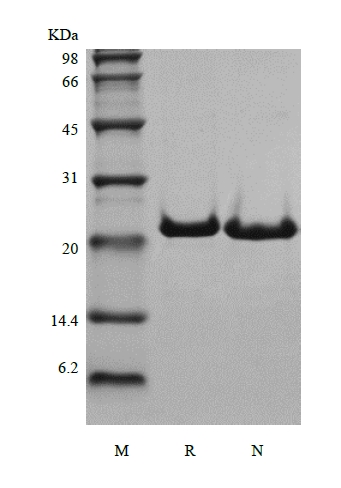| Official Full Name |
Recombinant Rhesus Macaque Interleukin-6 (rRhIL-6) |
| Squence |
 |
| Amino Acid Sequence |
|
| Synonyms |
|
| Accession Number |
|
| GeneID |
|
| Summary |
|
| Source |
Escherichia coli. |
| Molecular Weight |
|
| Biological Activity |
Fully biologically active when compared to standard. The ED50 as determined by a cell proliferation assay usingIL-6-dependent murine 7TD1 cells is less than 0.1 ng/ml, corresponding to a specific activity of > 1.0 × 107 IU/mg. |
| Appearance |
Sterile Filtered White lyophilized (freeze-dried) powder. |
| Formulation |
Lyophilized from a 0.2 um filtered concentrated solution in 50 mM Tris-HCl, pH9.0, 600 mM NaCl, with 0.02 % Tween-20. |
| Endotoxin |
Less than 1 EU/ug of rRhIL-6 as determined by LAL method. |
| Reconstitution |
We recommend that this vial be briefly centrifuged prior to opening to bring the contents to the bottom. Reconstitute in sterile distilled water or aqueous buffer containing 0.1 % BSA to a concentration of 0.1-1.0 mg/mL. Stock solutions should be apportioned into working aliquots and stored at < -20 °C. Further dilutions should be made in appropriate buffered solutions. |
| Stability and Storage |
Use a manual defrost freezer and avoid repeated freeze-thaw cycles.- 12 months from date of receipt, -20 to -70 °C as supplied.- 1 month, 2 to 8 °C under sterile conditions after reconstitution.- 3 months, -20 to -70 °C under sterile conditions after reconstitution. |
| References |
Interleukin-6 (IL-6) is an interleukin that is encoded by the IL-6 gene and acts as both a pro-inflammatory and anti-inflammatory cytokine. It is secreted by T cells and macrophages to stimulate immune response. Furthermore, It plays an essential role in the final differentiation of B-cells into Ig-secreting cells involved in lymphocyte and monocyte differentiation. It also induces myeloma and plasmacytoma growth and induces nerve cells differentiation acts on B-cells, T-cells, hepatocytes, hematopoietic progenitor cells and cells of the CNS. The rhesus macaque IL-6 contains 186 amino acids and it signals through a cell-surface type I cytokine receptor complex consisting of the ligand-binding IL-6Ralpha chain (CD126), and the signal- transducing component gp130 (also called CD130). |
| SDS-PAGE |
 |
| Safety Data Sheet (SDS) Download |
Click to download |
| Technical Data Sheet (TDS) Download |
Click to download |



